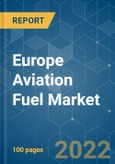The aviation fuel market in Europe is expected to grow at CAGR of more than 14% in the forecast period of 2020-2025. The increasing number of air passengers, on account of the cheaper airfare in recent times, stronger economic conditions, and increasing disposable income are among the major driving factors for the market. Efforts to increase the share of biofuels in the aviation sector is also driving the market considerably. However, the recent outbreak of COVID-19 tremendously affected the consumption of aviation fuel. With the closure of international and domestic airlines to curb the spread of the virus, the demand for aviation fuel is expected to decline during the pandemic.
Key Highlights
- With increasing connectivity globally and decreasing airfares, the commercial sector is expected to dominate the Europe aviation fuel market during the forecast period.
- The European Commission is aiming to increase the Sustainable Aviation Fuel (SAF) to 40% by 2040 to reduce greenhouse gas emissions. The initiative is expected to create significant opportunities in the aviation fuel market.
- With the largest market size in Europe, Russia is leading the market in the region and is likely to continue its dominance during the forecast period as well.
Key Market Trends
Commercial Sector to Dominate the Market
- Commercial aviation includes operating scheduled and non-scheduled aircraft, which involves commercial air transportation of passengers or cargo. The commercial segment is one of the largest consumers of aviation fuel, and it accounts for a quarter of total operating expenditure for an airline operator.
- Air transportation of passengers in European countries is increasing considerably. Germany reported around 227 million passengers' transportation by air in 2019.
- Air transport is a critical economic activity in the United Kingdom, accounting for about 4.5% of the UK's GDP in 2018 (IATA). The country has the largest air connectivity in Europe, which grew by 36% between 2013 and 2018 (IATA).
- In 2019, the total number of passengers carried by commercial airlines rose to around 4.54 billion, which was 5.58% higher than the previous years. Europe accounted for 26.4% of the total world aviation traffic in 2018.
- The countries in the region are slowly easing the lockdowns and are reopening air travel markets. This is expected to increase the demand for the jet fuel from the low levels registered in the first and second quarters of 2020, and the consumption of jet fuel is expected to increase further after 2021.
Russia to Dominate the Market
- In 2019, Russia's airlines collectively carried a record number of 128.12 million passengers, registering a 10.2% growth, as compared to the previous year (Federal Air Transport Agency, Russia).
- The Russian Air Force is expected to have more than 4,000 aircraft, and the country worked on a military modernization program, which was funded by rapidly increasing military spending, driving the demand of aviation fuel in the defense sector.
- Moreover, 55 new Su-57 combat aircraft were expected to be introduced by 2020, with deliveries of the aircraft expected to be starting by the end of this year. Hence, the increase in air force planes is expected to drive the aviation fuel market growth during the forecast period.
- According to Boeing, Russia and other CIS nations would require a total of 1,300 aircraft in the next two decades, owing to the increasing air passengers and air connectivity. With the expected increase in aircraft, the market is likely to grow significantly.
- The aviation fuel market size in Russia is expected to grow significantly. Commercial aviation sector is also one of the major consumers of aviation fuel in the country.
- However, due to the COVID-19 pandemic, until the end of 2021, the market studied is expected to be restrained, post which, with increasing passengers and air travel demand, the aviation fuel market is expected to grow for the rest of the forecast period.
Competitive Landscape
The Europe aviation fuel market is moderately fragmented. Some of the major companies include PJSC Gazprom, BP PLC, Royal Dutch Shell PLC, Total SA, Neste Oyj, and others.
Additional Benefits:
- The market estimate (ME) sheet in Excel format
- 3 months of analyst support
This product will be delivered within 2 business days.
Table of Contents
Methodology

LOADING...








